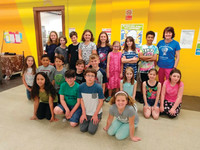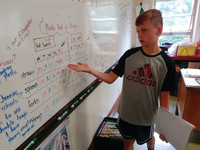By JEN COWART The students in the fourth grade at Rhodes Elementary School usually choose an area in which they'd like to make an impact before the end of their fourth-grade school year. Last year, students saw their impact on the school community as the
This item is available in full to subscribers.
We have recently launched a new and improved website. To continue reading, you will need to either log into your subscriber account, or purchase a new subscription.
If you are a current print subscriber, you can set up a free website account by clicking here.
Otherwise, click here to view your options for subscribing.
Please log in to continue |
|


The students in the fourth grade at Rhodes Elementary School usually choose an area in which they’d like to make an impact before the end of their fourth-grade school year. Last year, students saw their impact on the school community as the school mascot was changed from the tiger to the horseshoe crab, a mascot with ties to the Ocean State.
Once again this year, the students in the fourth grade looked to make an impact that would be felt locally.
“We decided after thinking all year about it that what we wanted to do for our school project would be something with the overuse of plastic, because we are the Ocean State,” said Willa Stefanski.
“Since we are the Ocean State, we wanted to save the ocean because a lot of animals are getting hurt every time plastic goes into the ocean, especially straws,” said Chole Mercedes. “We wrote letters and we said that we estimated 9,820 straws were used this year just at Rhodes, and that’s way more when you think of all the elementary schools using straws. It’s hurting a lot of animals and it’s hurting the environment. It’s not just hurting one animal, it’s hurting a lot more and it’s hurting baby animals.”
“We are trying to get rid of the ocean plastic because it’s invading the habitat of the ocean animals such as the horseshoe crab,” said Thora Corcoran.
Another related issue the students were looking to conquer was the use of single-use Styrofoam trays in the school cafeteria.
“We sent letters to Aramark and we told them that we estimated we were using 9,576 trays a school year, and those take a long time to break down. They are not biodegradable and they blow away in the landfill,” said Jack Mefford. “Now we are using hard plastic trays.”
The students spent time tracking their data as a class and in small groups and were astounded by the numbers they were gathering. Although they had their data to back up their case, they found that there were roadblocks to getting the single-use plasticware removed from the cafeteria.
“Spoons were hard to get rid of,” said Liv D’Acosta-Robinson. “There are a lot of hand foods but things like applesauce or strawberries in juice really needed a spoon and they’re extremely bad for the environment. We use less spoons than straws but we could go without the straws pretty easily. Now we would probably find that we were using the most spoons in a year. The next generation needs a save environment to live in, clean beaches when you put your feet in the water.”
According to Xavier Rios, when the class tracked their data for a week in April, they found the numbers to be staggering.
“We used 5,400 single-use plastic forks per year,” said Stefanski.
“We read an article that stated that by 2050 there will be more plastic in the ocean than fish,” said Emma-Rose Shaw. “The plastic is ingested by fish and we eat fish, it’s a chain reaction. All animals will suffer and the food chain will slowly die off.”
Besides the need for a spoon for messier lunch items, the students found that dishwashing was an issue when it came time to try to implement real silverware in the cafeteria instead of plasticware. Having a good quality dishwasher that could wash the reusable trays and silverware was an issue, according to the students, as was the fact that the Aramark workers would need to be paid extra time on the job to be there to wash and put away the trays and silverware, which was also an issue. The students tried to think of some compromises and alternatives to combat some of the issues.
“When we heard back from the school committee chairwoman, Janice Ruggieri, that the dishwasher would cost more money, we thought that since we would be reusing the silverware and the hard trays, we would not be paying for those things over and over again anymore,” said Mackenzie Rose. “It would be better for the environment, and if our school started this, imagine how much of a big difference we could make if all schools would do the same thing.”
Real-life experiences also played into their solutions.
“We asked about having replacement paper straws instead of plastic because one of our teachers had them in a restaurant, so we know they exist,” said JP Beyer. “We asked if we could at least have a recycling bin in our cafeteria since we still don’t have one.”
As time went on, they began to see the results of their efforts, including seeing hard plastic trays in use instead of styrofoam.
“We felt a big victory with that, being just fourth-graders,” said James Conway.
Brighid Weber agreed.
“This was the beginning of something excellent,” she said.
The students were excited to see those they were writing to in agreement with them.
“The mayor agreed with our ideas and so did the lunch company,” said Claire Kiley. “It was good to know that people like us, fourth-graders, can make a change in our state.”
Fourth-grade teacher, Susan Weber was proud of this year’s change-makers.
“They were really committed to their cause,” she said. “They were very excited to have a voice and I’m very proud of them.”
Comments
No comments on this item Please log in to comment by clicking here